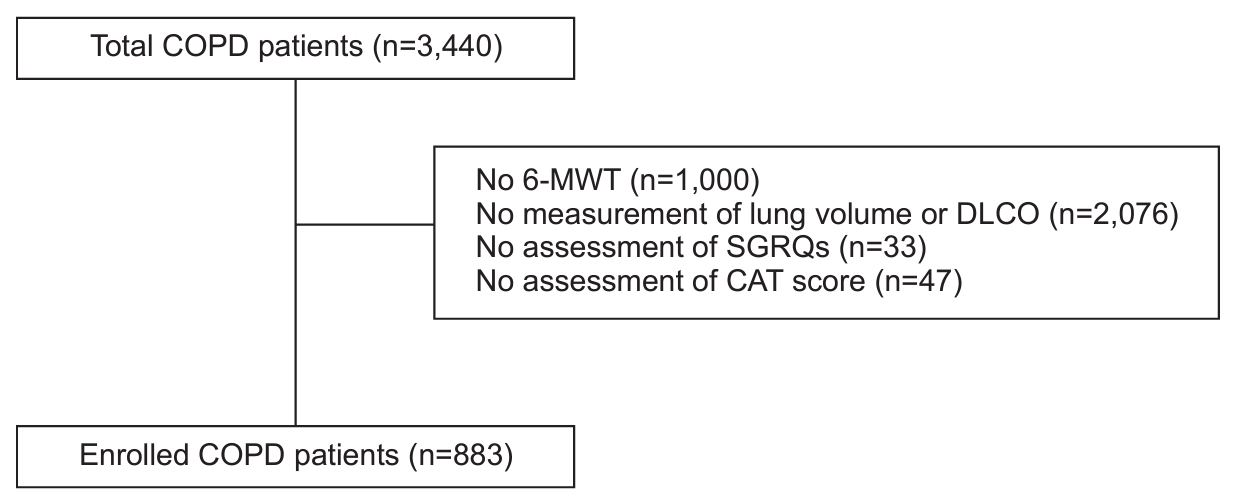 |
 |
| Tuberc Respir Dis > Volume 87(2); 2024 > Article |
|
Abstract
Background
Methods
Results
Notes
Authors’ Contributions
Conceptualization: Kim TH, Kim HC. Methodology: Kim HC. Formal analysis: Kim HC. Data curation: Heo IR, Kim NY, Park JH, Yoon HY, Jung JY, Ra SW, Jung KS, Yoo KH. Software: Kim HC. Validation: Kim HC. Writing - original draft preparation: Kim TH, Kim HC. Writing - review and editing: Heo IR, Kim NY, Park JH, Yoon HY, Jung JY, Ra SW, Jung KS, Yoo KH. Approval of final manuscript: all authors.
Fig. 1.

Fig. 2.

Table 1.
Values are presented as mean±standard deviation or number (%).
COPD: chronic obstructive pulmonary disease; BMI: body mass index; CCI: Charlson comorbidity index; FEV1: forced expiratory volume in 1 second; FVC: forced vital capacity; DLCO: diffusion capacity carbon monoxide; RV: residual volume; TLC: total lung capacity; mMRC: modified Medical Research Council; CAT: COPD assessment test; SGRQ: St. George's Respiratory Questionnaire; BDI: Beck depression inventory; 6-MWD: 6-minute walk distance; WBC: white blood cell; BUN: blood urea nitrogen; IgE: immunoglobulin E; CRP: C-reactive protein; IL: interleukin; BNP: brain natriuretic peptide.
Table 2.
Values are presented as mean±standard deviation or number (%).
FEV1: forced expiratory volume in 1 second; 6-MWD: 6-minute walk distance; BMI: body mass index; CCI: Charlson comorbidity index; FVC: forced vital capacity; DLCO: diffusion capacity carbon monoxide; RV: residual volume; TLC: total lung capacity; mMRC: modified Medical Research Council; CAT: COPD assessment test; SGRQ: St. George’s Respiratory Questionnaire; BDI: Beck depression inventory; WBC: white blood cell; BUN: blood urea nitrogen; CRP: C-reactive protein; IL: interleukin; BNP: brain natriuretic peptide.
Table 3.
6-MWD: 6-minute walk distance; COPD: chronic obstructive pulmonary disease; FEV1: forced expiratory volume in 1 second; OR: odds ratio; CI: confidence interval; BMI: body mass index; CCI: Charlson comorbidity index; DLCO: diffusion capacity carbon monoxide; RV: residual volume; TLC: total lung capacity; mMRC: modified Medical Research Council, CAT: COPD assessment test; BDI: Beck depression inventory; SGRQ: St. George’s Respiratory Questionnaire.
Table 4.
6-MWD: 6-minute walk distance; COPD: chronic obstructive pulmonary disease; FEV1: forced expiratory volume in 1 second; OR: odds ratio; CI: confidence interval; BMI: body mass index; CCI: Charlson comorbidity index; DLCO: diffusion capacity carbon monoxide; RV: residual volume; TLC: total lung capacity; mMRC: modified Medical Research Council; CAT: COPD assessment test; BDI: Beck depression inventory; SGRQ: St. George’s Respiratory Questionnaire.
References
- TOOLS
-
METRICS

-
- 0 Crossref
- 0 Scopus
- 816 View
- 83 Download
- ORCID iDs
-
Tae Hoon Kim

https://orcid.org/0000-0002-3438-006XHo Cheol Kim

https://orcid.org/0000-0002-3262-0672 - Funding Information
-
Korea National Institute of Health
https://doi.org/10.13039/501100003653
2016ER670100
2016ER670101
2016ER670102
2018ER67100
2018ER67101
2018ER67102
2021ER120500
2021ER120501
2021ER120502 - Related articles


 PDF Links
PDF Links PubReader
PubReader ePub Link
ePub Link Data Sharing Statement
Data Sharing Statement Full text via DOI
Full text via DOI Print
Print Download Citation
Download Citation



